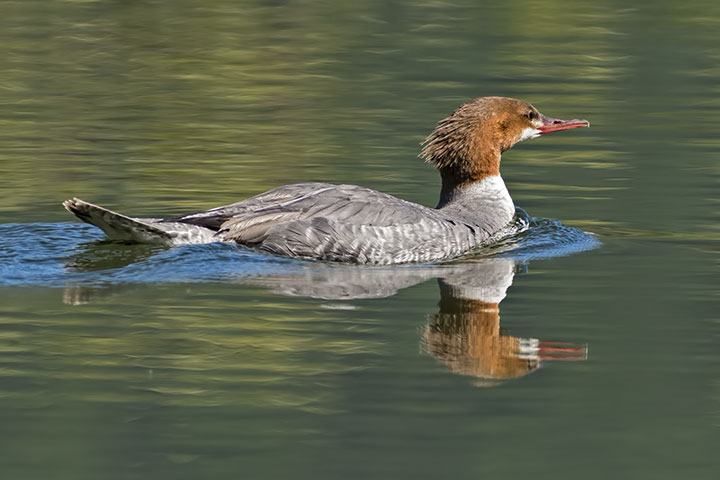Six months ago I posted merganser planing. It showed pictures of swimming Common Mergansers that had moved from displacement mode to planing mode.
Most things moving across the surface of water do so in displacement mode: they are moving so slowly across the water that weight is supported (primarily) by buoyancy (static pressure). This applies equally to kayaks and supertankers, muskrats and moose. Some boats and some birds are capable of planing: they are moving so quickly across the water that weight is (primarily) supported by the lift provided by the rush of water against a sloping bottom (dynamic pressure). Planing is not an easy trick to pull off; to achieve it takes more power than most animals can muster. Yet, some can do it.
Planing boats have: A broad flattish bottom (against which the rushing water provides lift); A hard chine (which helps directional stability and disperses spray; Paramount is an immersed transom with a sharp transition to the hull (required for the separation of the flow from the boat).
Being able to plane requires more than just power; it also requires the boat or bird to have the right shape. Boat designers have known this for a century. The crucial shape that allows a boat to plane is an immersed transom joined to the bottom of the hull at about a right-angle. This allows the water underneath to sweep out past the stern and separate easily from the boat rather than flowing up the transom as it would with the longitudinally rounded stern long favoured by rowboats and ducks.

A Common Merganser swims in displacement mode. Her tail is up and her stern is rounded. (2013/06/06)
A boat designer, who read my posting about merganser planing, wrote me to emphasize the point that planing absolutely requires an immersed and sharp transition between hull and transom. He then suggest that birds are incapable of planing because birds have rounded butts. I understood his point about the shape of birds, and I understood his point about the necessity of the sharp transition. Yet, I had seen birds plane. How did they manage this trick?
I waited and watched. With the coming of spring, I saw Mallard chicks planing and the light went on: the birds that do this are shape shifters. While swimming in displacement mode, the bird’s butt certainly is rounded; when it is swimming in planing mode, the tail feathers are pressed down strongly to create the necessary sharp underwater transition.
I had to wait until this week before getting a somewhat overhead view of a duck doing this. (With most side views, the duck’s wake obscures the view of the depressed tail).
A female Common Merganser is planing. Weight is supported by the lift provided by the rush of water against a sloping belly. Wings are held tight to the side to provide a hard chine. Tail feathers are forced down to give the sharp underwater transition needed for planing.

